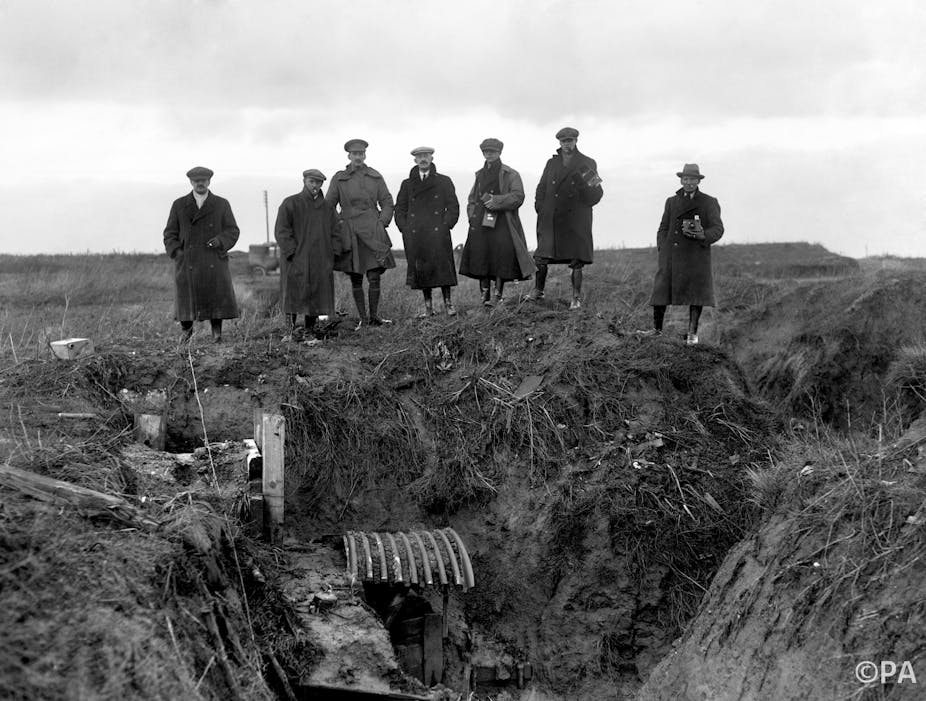Taken immediately after the ceasefire that ended the first Gulf War in 1991, Kenneth Jarecke’s photograph of the charred corpse of an Iraqi soldier in his burned-out jeep is one of the few memorable images of that conflict. Yet as a recent article in The Atlantic explains, high-level editors of news periodicals in the US refused to publish the image at the time, despite being urged to do so by their photo directors.
The problems and debates that surround such images of war, violence, and atrocity, never quieten. And it is striking how many of the problems they address emerged during and after World War I.
The power of the Iraqi photograph is not the property of the image alone; it depends on its relationship with other media images of the first Gulf War. The Western press offered a sanitised view of the conflict. This was partly because of military control of journalists in the war zone and partly because of the prevalence of imagery from the military’s own optical technology.
This technology facilitated the precision aiming of weapons in so-called “surgical strikes” and was then disseminated through TV news broadcasts, leading to what John Taylor terms the disappearance of the body:
The objects of violence are unknown and distant, or they are lumped together in masses and lack individuality … Killing is done at a distance, and if the victims are optically separated from their killers the insulation of combatants and viewers from the action is likely to be enhanced.

So the public understanding of the first Gulf War was determined to a large degree by optical technologies that operated at a distance. When this distance is collapsed – as in Jarecke’s photograph – we are, it is argued, faced with the truth of war. This point was made forcibly by Jonathan Jones in response to controversy surrounding the publication of photographs and film footage of the last moments of Muammar Gaddafi. As Torie Rose DeGhet says in the Atlantic article: “Photos like Jarecke’s not only show that bombs drop on real people; they also make the public feel accountable.”
Sanitisation and war
But history might cause us to question the value of photography as a truth-telling medium that has unique power to make people accountable, acknowledge the full horror of war and effect political change.
In World War I, both Germany and Britain operated a primitive form of embedded journalism – and the photographic reporting of the conflict in the news media was massively sanitised in ways that will be familiar to modern readers.
The majority of images showed the everyday life of well-fed, cheery troops behind the lines. Captured enemy soldiers and materiel confirmed military successes. Images of the wounded emphasised rehabilitation and professional care. In the German press, military hardware and its destructive power were frequently foregrounded, encouraging expectations of victory on the grounds of technological superiority.

The similarity to more recent war reporting is striking, especially the emphasis on technological superiority, and on medical care for casualties, as in regular BBC news items looking at state-of-the-art prosthetic limbs for amputee veterans returning from Iraq or Afghanistan.
War against war
In Germany, the political turmoil that followed World War I led to a highly polarised struggle for the meaning and memory of the war. Photography was not immediately mobilised in this struggle; it was Ernst Friedrich’s 1924 publication War against War that finally depicted photographically the human consequences of total war in all their brutality.
War against War was a bestseller: ten editions had been published by 1930 and 400,000 copies had been sold worldwide by 2000. The book contains some 180 photographs. Most depict gruesome death, rotting corpses, hangings and executions, and veterans with horrific facial wounds.
Friedrich hoped his book would inspire opposition to war. But despite its commercial success, our knowledge of subsequent events suggests it had little lasting political effect at either an individual or a collective level. In so far as War against War led to opposition, it was opposition to Friedrich. He was hounded by the German authorities and only narrowly escaped certain murder at the hands of the Nazis by emigrating in 1933.
Friedrich’s case reveals a problem that continues to bedevil discussions of war and atrocity photographs. Susan Sontag wrote that “for a long time some people believed that if the horror could be made vivid enough, most people would finally take in the outrageousness, the insanity of war”.
But we have not shed this belief. We continue to invest much in photography as a truth-telling medium and a politically transformative instrument, which is why it continues to generate controversy and debate. But there is still all too little evidence of photography’s ultimate ability to bring about political change.

